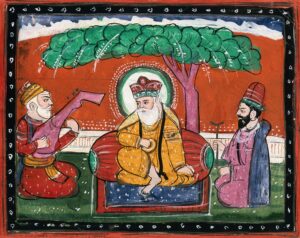Guru Hargobind Sahib Ji, the sixth Guru of the Sikhs, was born on June 19, 1595, in Guru Ki Wadali, near Amritsar, to Guru Arjan Dev Ji and Mata Ganga Ji. He was only 11 years old when his father, Guru Arjan Dev Ji, attained martyrdom in 1606 at the hands of the Mughal emperor Jahangir. His father’s brutal execution deeply impacted young Hargobind and marked a historic shift in the Sikh community. Before his martyrdom, Guru Arjan Dev Ji instructed his son to raise the sword, to resist injustice, and to uphold righteousness alongside spiritual values. Thus, Guru Hargobind Ji introduced the concept of “Miri-Piri” — a spiritual and temporal (political) duality.
Upon becoming Guru at age 11, Guru Hargobind Ji donned two swords symbolizing this doctrine:
Piri (spiritual authority) — representing his role as Guru and spiritual guide.
Miri (temporal power) — representing his duty to protect the oppressed and uphold justice.
This marked a turning point in Sikhism. The Guru transformed the Sikh community into a saint-soldier tradition, encouraging Sikhs to be spiritually devoted and physically strong. He built the Akal Takht (Throne of the Timeless One) in 1606, directly facing the Harmandir Sahib (Golden Temple) in Amritsar. The Akal Takht became the center of political and military deliberation and is still the highest seat of authority in Sikhism today.
Guru Hargobind Ji also started maintaining a standing army, encouraged martial training, and carried weapons — all revolutionary steps for a spiritual leader of that time. This was not to conquer lands but to resist tyranny, defend the faith, and protect the rights of the people, especially the downtrodden. His moves alarmed the Mughal emperor Jahangir, who had him imprisoned in the Gwalior Fort under the pretext of a political threat. However, during his imprisonment, Guru Hargobind Ji impressed even his captors with his grace, wisdom, and divine aura.
A famous incident during this time is the “Bandi Chhor Divas” (Day of Liberation). When Jahangir finally ordered Guru Hargobind Ji’s release, the Guru insisted that 52 imprisoned Hindu princes be released along with him. The emperor agreed on the condition that only those who could hold onto the Guru’s robe could leave. Guru Hargobind Ji had a special cloak made with 52 tassels, and each prince held onto one as he walked out — earning him the title “Bandi Chhor”, or Liberator of Prisoners. This event is celebrated joyfully by Sikhs on the same day as Diwali.
After his release, Guru Hargobind Ji continued to consolidate the Sikh community’s spiritual and military strength. He established new towns such as Kiratpur Sahib, encouraged trade, built forts, and made the Sikh community self-reliant. Throughout his life, he fought several defensive battles against the Mughals, including notable ones at Amritsar, Rohilla, and Kartarpur. These battles were not for conquest but for survival and self-defense. Despite his martial leadership, Guru Hargobind Ji remained deeply spiritual and always advocated justice, compassion, and truth.
He also emphasized interfaith harmony and maintained friendly relations with many Hindus and Muslims, including Sufi saints. His philosophy was not of hatred but of resistance to tyranny, promoting a balanced life of devotion and valor.
Guru Hargobind Ji passed the spiritual light of Sikhism to his grandson Guru Har Rai Ji in 1644, before he passed away on March 3, 1644, at Kiratpur Sahib. His life left a powerful legacy — a community prepared to face political oppression while staying grounded in faith, humility, and service.
ar dapibus leo.















 Beyond its religious functions, the Gurdwara serves as a hub for community activities, bringing together the Sikh sangat for prayers, kirtan, and community events. The Gurudwara Baba Deep Singh affiliation underscores its dedication to upholding Sikh principles, contributing to the rich cultural tapestry of the Ganganagar area.
Beyond its religious functions, the Gurdwara serves as a hub for community activities, bringing together the Sikh sangat for prayers, kirtan, and community events. The Gurudwara Baba Deep Singh affiliation underscores its dedication to upholding Sikh principles, contributing to the rich cultural tapestry of the Ganganagar area.